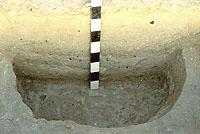
Feature 1, a good example of one
of the most common and enigmatic outside features, is
a cylindrical pit with a flat bottom. These were frequently
trash-filled, and sometimes contained cached grinding
stones. These pits were likely used for concealed storage
during periods of short-term or seasonal abandonment
of the site. By matching broken artifacts, it was learned
that most of these features were used during the occupation
of the pueblo and not that of the pithouses.
Click images to enlarge
|
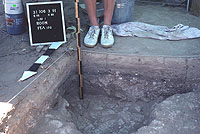
Feature 132, a cross section of an
average-sized roasting pit or oven where large pieces
of adobe were used to retain heat. Rocks were frequently
used in features of this sort elsewhere in the Hueco
Bolson, but surface rocks do not occur in the vicinity
of the site.
|
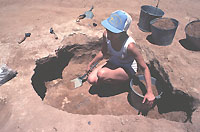
Extramural or outside features were
quite common and varied. This is an example of one of
the more common features, a probable storage pit later
filled with trash. Jeanine Collins is the excavator.
|
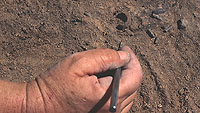
Burned bone ring and shell beads
being exposed. These were found within an irregular,
trash-filled pit between pithouse rooms 13 and 17. This
deposit in the outside area is not associated with any
structure and perhaps represents some sort of ritual
offering.
|
|
The systematic investigation of the extramural
areas—those that lay outside the walls of the pueblo—was
an essential part of the research effort at Firecracker Pueblo.
This had not been attempted before at a pueblo site in the
Jornada region. The approach was simple, and eventually just
over 20% of the site area outside of structures was excavated.
First, a checkerboard of one-meter squares was dug, each separated
by three-meter gaps. Then, another one-meter square was excavated
in the middle of the gap defined by every four excavated squares.
The checkerboard excavations were expanded and sometimes connected
to learn more about particular features and deposits. Finally,
a series of backhoe trenches was run north-south across much
of the site. These techniques enabled the definition of stratigraphy
throughout the site, the recognition of patterned distributions
of features and artifacts, and the recording of 243 outside
features and one burial.
The outside features varied greatly in size,
appearance, and function. Most were pits of one sort or another—trash
pits large and small; shallow pits containing small cooking
hearths; small postholes sometimes found in patterns, sometimes
isolated; curious cylindrical pits believed to be temporary
food storage bins; large roasting pits containing adobe blocks
that apparently functioned as substitute cooking stones; and
even larger borrow pits where adobe-making and caliche-plaster
materials were obtained. There were also trash deposits or
middens, some of which accumulated on the ground surface,
while other trash was dumped into pithouses and other depressions.
Most outside features, trash middens, and the
trash within pithouses can be attributed to the pueblo occupation.
This was determined by a careful study of the distribution
of certain items including matching sherds of the same vessels,
fragments of ground-stone tools, and fragments of unusual
types of stone. Over half of the pueblo room floors, nearly
half of the outside features, and nearly all of the trash-filled
pithouses had pieces of artifacts which could be matched within
one another, strongly suggesting that they were used at the
same time. In contrast, no matches were found between objects
found on pithouse floors and those within exterior features.
The outside features were not randomly distributed
but were instead formed more or less concentric zones or arcs
extending outward from the pueblo. The basic pattern is a
clean area immediately around the pueblo, ringed by small
cooking hearths and trash dumps and patterns of postholes
suggesting temporary structures like shade remadas. Outside
these were large roasting pits and borrow pits. These patterns
are harder to discern at the western end of the pueblo where
the addition of rooms apparently pushed back the area used
for these features during the life of the pueblo.
In more detail, the inner zone is the space
next to the south side of the pueblo that is fairly clear
of features and trash. At a distance of 4-8 meters (about
13-26 feet) out from the pueblo and arcing towards the east
and west ends of the pueblo, some trash and small hearths
were found. These hearths appear as lenses of ash and charcoal
or basin-shaped pits with ash and charcoal. Between 6 and
15 meters (about 20-50 feet) from the pueblo, there is an
arc where most of the features and trash deposits are concentrated.
The features are varied and include small pits and postholes,
small and medium-sized, irregularly shaped pits, and cylindrical
pits. Trash and features are most dense immediately to the
south of the core rooms of the pueblo. Finally, there is a
perimeter defined by large borrow pits, roasting pits or ovens,
and diminishing trash. The roasting pits or ovens are interesting
for they are filled with ash, charcoal, and large fragments
of burned adobe. There are no surface rocks in the site vicinity,
and adobe was obviously being substituted for rock in these
ovens.
The addition of rooms to the pueblo had the
effect of moving these arcs of features and trash outward
and blurring the described pattern. This is particularly apparent
for the western part of the site, while the highway has truncated
the eastern area of features. There are few features and little
trash on the northern side of the pueblo. The evident spatial
arrangement of features and trash pits would suggest an intensive
and perhaps lengthy occupation that demanded maintenance of
space and separation of activities with conflicting requirements.
Two pieces of information, however, could suggest an alternative
scenario.
First, nearly all of the ground stone associated
with the pueblo occupation was found buried in outside pits.
These are not worn and broken pieces of groundstone, but massive
and little used metates and manos. These are assumed to represent
items that were cached (hidden) as might be expected if Firecracker
Pueblo was occupied intermittently or seasonally. Second,
there are 47 pits with circular outlines, vertical sides,
and flat bottoms cut into the natural caliche layer that underlies
the site. These pits are not plastered, but some contained
shaped fragments of adobe that may be the remnants of some
sort of cover or seal. They range from .5 to 2 meters (1.5
to 6.5 feet) in diameter and .4 to .6 meters (16-24 inches)
in depth (the original depths were probably greater -- the
site area had been deflated by wind erosion and partially
graded by machinery). Most are layered with trash and sand
deposits, and some are filled only with clean blow sand.
These enigmatic cylindrical features have been
called storage pits when found in Pithouse or Archaic period
sites of the region and the Southwest. But exterior storage
pits are not typical of situations where people depend on
corn and live in pueblos year-round. Exterior storage pits
are often associated with populations that are seasonally
mobile. In this case, storage pits may have been used to conceal
stored foodstuffs when the area was not occupied. If so, this
is another indication that the site was not a permanent village,
but was instead occupied intermittently, perhaps seasonally.
In 1980 when the work was begun at Firecracker
Pueblo, an average of one burial had been recorded for every
11 or 12 rooms excavated at El Paso phase pueblos elsewhere.
These burials were also almost all adults. With the extensive
and systematic testing of outside areas and the excavation
of structures, only a single burial of an 18- to 22-year-old
woman was found in an outside area at Firecracker Pueblo.
There was no evidence for a cemetery, cremations, secondary
burials, or children. Given the extensive excavations at Firecracker
and what is known about other El Paso phase pueblo sites,
the scarcity of burials is yet another clue that the people
who lived at Firecracker were not living there year-round.
|
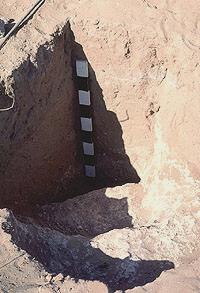
A borrow pit. This photo shows a
stepped entry into a large pit that has only partially
been exposed. This pit was excavated with digging sticks
(stick marks were found in side walls) into and through
the caliche layer. Caliche was used to plaster floors
and walls of pueblo rooms and pithouses and as an adobe
additive.
|
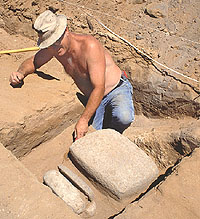
Large metate and three matching manos
discovered by Gene Collins in an outside pit. These
appear to be cached items, apparently hidden by someone
who expected to return to the site. The metate weighs
80 pounds and is made of vesicular basalt hauled to
the site from sources some 40 miles away.
|
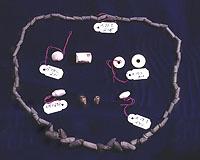
Burned shell bead and fossil coral
bead necklace found in an irregular, trash-filled pit
between pithouse rooms 13 and 17. The unburned shell
ornaments came from various places at the site. In general,
all the nicer artifacts came from refuse accumulations.
|
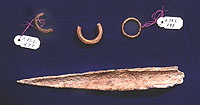
Bone awl and burned bone rings found
in an irregular trash-filled pit between rooms 13 and
17.
|
| |
|
If the cylindrical pits at Firecracker are storage
pits used to conceal food, as suspected, then they provide
strong evidence that the site was not a permanent village,
but was instead occupied intermittently, perhaps seasonally.
|
|